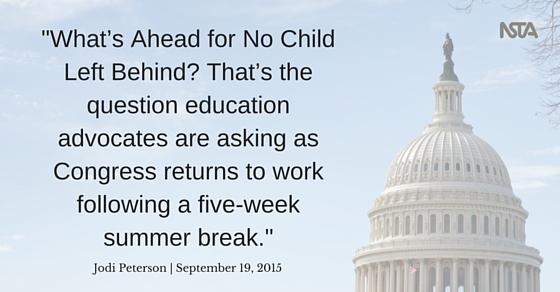Legislative Update
What’s Ahead for No Child Left Behind?
By Jodi Peterson
Posted on 2015-09-19
What’s ahead for No Child Left Behind (NCLB)? That’s the question education advocates are asking as Congress returns to work following a five-week summer break faced with a full slate of issues to address, including the threat of a government shutdown on October 1 if no budget agreement is reached.
So what does a full Congressional calendar mean for the reauthorized NCLB? (Read what happened this summer here and here). Congressional leaders [House Education and the Workforce Committee Chairman John Kline (R-MN); Ranking Member Bobby Scott (D-VA); Senate Health, Education, Labor, and Pensions Committee Chairman Lamar Alexander (R-TN); and Senate Ranking Member Patty Murray (D-WA)] have met and are working to reconcile the differences in the House and Senate versions of their bills to reauthorize the Elementary and Secondary Education Act (NCLB). Rep. Kline will lead the conference committee, and additional conference members are expected to be named in late September or early October. The goal is to reconcile a bill that will pass both chambers and the President will sign by the end of the year.
The big issues still to be resolved include the cuts in federal programs; a provision that would let students opt out of testing; and portability. Accountability issues also continue to dominate the conversation. The House bill has no accountability criteria, and the Senate bill requires states to have accountability systems, but there are no federal safeguards to intervene or report out low performing schools. Many groups continue to push conferees to include stronger provisions that would hold states accountable for identifying and addressing educational disparities.
In related news, Rep. Kline has announced that he will not be seeking re-election, and is optimistic that Congress will finish a bill this year (he will continue in his current role thru the end of 2016). If the House continues under Republican majority after the 2016 election, possible successors include Representatives Joe Wilson and Virginia Foxx.
Both the House ESEA bill (the Student Success Act, H.R. 5,) and the Senate ESEA bill (Every Student Achieves Act, S. 1177), would retain current-law requirements for states to continue to assess student performance in mathematics and science and that states be required to adopt rigorous standards in these subjects.
The Senate Bill contains a provision (Title II-E) that would provide each state with dedicated resources focused on improving teaching and learning in STEM subjects. This provision would support partnerships between schools, businesses, non-profits and institutions of higher education which would support a wide range of STEM-focused objectives, including recruitment, retention, and professional development of educators, expansion of learning opportunities both in and outside the classroom, and closing achievement gaps for at-risk and high-need student populations. We are hopeful that the conferenced bill will contain this Senate language.
Government Shutdown in Sight?
Lots of crystal ball gazing this week as political pundits from the left and the right are speculating as to whether the federal government will shut down on Oct. 1 if Congress cannot pass a budget bill for the fiscal year.
A continuing resolution, (CR) would extend FY 15 funding for another year, which would be the best scenario for Department of Education programs which would see major cuts in funding in the FY 2016 spending bills proposed to date.
To wit, the House of Representatives (once again) eliminated funding for the Mathematics and Science Partnerships (Title IIB) at the U.S. Department of Education under the 2016 Labor, Health and Human Services (HHS), and Education appropriations bill, stating “these activities can be carried out under other authorities funded in this bill and through other federal agencies such as the National Science Foundation.”
The Senate education funding bill did provide continued support for the Math and Science Partnership program at the Department of Education, at the level of $141,299,000.
The National Science Teachers Association (NSTA) and the National Council of Teachers of Mathematics (NCTM) will be sending a joint letter asking members of Congress to support the Senate funding level for the Department of Education Math and Science Partnership program.
Another big issue for education this year is the effort to stop sequestration and take a more balanced approach to deficit reduction.
Nondefense discretionary (NDD) programs—ranging from education and job training, to housing and science, to natural resources and veterans services, to public health, safety and security—have been cut dramatically and disproportionately in recent years as lawmakers work to reduce the deficit. Many groups are urging Congress to replace sequestration with a balanced approach to deficit reduction that takes into account the deep cuts NDD has already incurred since 2010 and ensure sequestration relief is equally balanced between NDD and defense programs. Learn more here.
Stay tuned, much more to come in the weeks ahead.
Jodi Peterson is Assistant Executive Director of Legislative Affairs for the National Science Teachers Association (NSTA) and Chair of the STEM Education Coalition. e-mail Jodi at jpeterson@nsta.org; follow her on Twitter at @stemedadvocate.
The mission of NSTA is to promote excellence and innovation in science teaching and learning for all.
Follow NSTA
Disclaimer: The views expressed in this blog post are those of the author(s) and do not necessarily reflect the official position of the National Science Teaching Association (NSTA).


